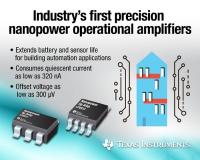 |
 |
 |
| RU |
|
Login
Newsletters
There is no newsletter category found. Information
|
TI introduces the industry's first precision nanopower operational amplifiers 12/06/2016 Texas Instruments (TI) introduced the industry's first precision nanopower operational amplifiers (op amps). The LPV811 and LPV812 consume quiescent current as low as 320 nA and are part of a family of four new ultra-low-power op amps. With up to 60 percent lower power consumption than competitive precision op amps and offset voltage as low as 300 µV, the new family of op amps extends battery and sensor life for applications such as building automation, wired and wireless sensor nodes, and wearables. For more information about the family or to order samples, see www.ti.com/nanopower-pr.Key features and benefits of the LPV811 family
To find more details click the following link. Company profile: Texas Instruments Related Information:
Companies' news
|
Current issue
Search
|
|
|
| © "Test & Measuring Instruments and Systems" ("KIPiS"), 2000-2024 |

























